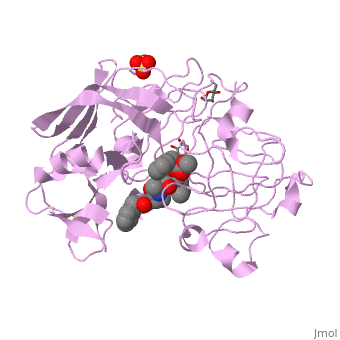1ppm: Difference between revisions
No edit summary |
No edit summary |
||
| Line 4: | Line 4: | ||
|PDB= 1ppm |SIZE=350|CAPTION= <scene name='initialview01'>1ppm</scene>, resolution 1.7Å | |PDB= 1ppm |SIZE=350|CAPTION= <scene name='initialview01'>1ppm</scene>, resolution 1.7Å | ||
|SITE= | |SITE= | ||
|LIGAND= <scene name='pdbligand=MAN:ALPHA-D-MANNOSE'>MAN</scene>, <scene name='pdbligand= | |LIGAND= <scene name='pdbligand=ARA:ALPHA-L-ARABINOSE'>ARA</scene>, <scene name='pdbligand=MAN:ALPHA-D-MANNOSE'>MAN</scene>, <scene name='pdbligand=OPH:2-HYDROXY-3-PHENYL-PROPIONIC+ACID+METHYL+ESTER'>OPH</scene>, <scene name='pdbligand=PHQ:FORMIC+ACID+BENZYL+ESTER'>PHQ</scene>, <scene name='pdbligand=PLE:LEUCINE+PHOSPHINIC+ACID'>PLE</scene>, <scene name='pdbligand=SO4:SULFATE+ION'>SO4</scene> | ||
|ACTIVITY= [http://en.wikipedia.org/wiki/Penicillopepsin Penicillopepsin], with EC number [http://www.brenda-enzymes.info/php/result_flat.php4?ecno=3.4.23.20 3.4.23.20] | |ACTIVITY= <span class='plainlinks'>[http://en.wikipedia.org/wiki/Penicillopepsin Penicillopepsin], with EC number [http://www.brenda-enzymes.info/php/result_flat.php4?ecno=3.4.23.20 3.4.23.20] </span> | ||
|GENE= | |GENE= | ||
|DOMAIN= | |||
|RELATEDENTRY= | |||
|RESOURCES=<span class='plainlinks'>[http://oca.weizmann.ac.il/oca-docs/fgij/fg.htm?mol=1ppm FirstGlance], [http://oca.weizmann.ac.il/oca-bin/ocaids?id=1ppm OCA], [http://www.ebi.ac.uk/pdbsum/1ppm PDBsum], [http://www.rcsb.org/pdb/explore.do?structureId=1ppm RCSB]</span> | |||
}} | }} | ||
| Line 24: | Line 27: | ||
[[Category: Fraser, M E.]] | [[Category: Fraser, M E.]] | ||
[[Category: James, M N.G.]] | [[Category: James, M N.G.]] | ||
[[Category: hydrolase(acid proteinase)]] | [[Category: hydrolase(acid proteinase)]] | ||
''Page seeded by [http://oca.weizmann.ac.il/oca OCA ] on | ''Page seeded by [http://oca.weizmann.ac.il/oca OCA ] on Sun Mar 30 23:02:52 2008'' | ||
Revision as of 23:02, 30 March 2008
| |||||||
| , resolution 1.7Å | |||||||
|---|---|---|---|---|---|---|---|
| Ligands: | , , , , , | ||||||
| Activity: | Penicillopepsin, with EC number 3.4.23.20 | ||||||
| Resources: | FirstGlance, OCA, PDBsum, RCSB | ||||||
| Coordinates: | save as pdb, mmCIF, xml | ||||||
CRYSTALLOGRAPHIC ANALYSIS OF TRANSITION-STATE MIMICS BOUND TO PENICILLOPEPSIN: PHOSPHORUS-CONTAINING PEPTIDE ANALOGUES
OverviewOverview
The molecular structures of three phosphorus-based peptide inhibitors of aspartyl proteinases complexed with penicillopepsin [1, Iva-L-Val-L-Val-StaPOEt [Iva = isovaleryl, StaP = the phosphinic acid analogue of statine [(S)-4-amino-(S)-3-hydroxy-6-methylheptanoic acid] (IvaVVStaPOEt)]; 2, Iva-L-Val-L-Val-L-LeuP-(O)Phe-OMe [LeuP = the phosphinic acid analogue of L-leucine; (O)Phe = L-3-phenyllactic acid; OMe = methyl ester] [Iva VVLP(O)FOMe]; and 3, Cbz-L-Ala-L-Ala-L-LeuP-(O)-Phe-OMe (Cbz = benzyloxycarbonyl) [CbzAALP(O)FOMe]] have been determined by X-ray crystallography and refined to crystallographic agreement factors, R ( = sigma parallel to F0 magnitude of - Fc parallel to/sigma magnitude of F0), of 0.132, 0.131, and 0.134, respectively. These inhibitors were designed to be structural mimics of the tetrahederal transition-state intermediate encountered during aspartic proteinase catalysis. They are potent inhibitors of penicillopepsin with Ki values of 1, 22 nM; 2, 2.8 nM; and 3, 1600 nM, respectively [Bartlett, P. A., Hanson, J. E., & Giannousis, P. P. (1990) J. Org. Chem. 55, 6268-6274]. All three of these phosphorus-based inhibitors bind virtually identically in the active site of penicillopepsin in a manner that closely approximates that expected for the transition state [James, M. N. G., Sielecki, A.R., Hayakawa, K., & Gelb, M. H. (1992) Biochemistry 31, 3872-3886]. The pro-S oxygen atom of the two phosphonate inhibitors and of the phosphinate group of the StaP inhibitor make very short contact distances (approximately 2.4 A) to the carboxyl oxygen atom, O delta 1, of Asp33 on penicillopepsin. We have interpreted this distance and the stereochemical environment of the carboxyl and phosphonate groups in terms of a hydrogen bond that most probably has a symmetric single-well potential energy function. The pro-R oxygen atom is the recipient of a hydrogen bond from the carboxyl group of Asp213. Thus, we are able to assign a neutral status to Asp213 and a partially negatively charged status to Asp33 with reasonable confidence. Similar very short hydrogen bonds involving the active site glutamic acid residues of thermolysin and carboxypeptidase A and the pro-R oxygen of bound phosphonate inhibitors have been reported [Holden, H. M., Tronrud, D. E., Monzingo, A. F., Weaver, L. H., & Matthews, B. W. (1987) Biochemistry 26, 8542-8553; Kim, H., & Lipscomb, W. N. (1991) Biochemistry 30, 8171-8180].(ABSTRACT TRUNCATED AT 400 WORDS)
About this StructureAbout this Structure
1PPM is a Single protein structure of sequence from [1]. Full crystallographic information is available from OCA.
ReferenceReference
Crystallographic analysis of transition-state mimics bound to penicillopepsin: phosphorus-containing peptide analogues., Fraser ME, Strynadka NC, Bartlett PA, Hanson JE, James MN, Biochemistry. 1992 Jun 9;31(22):5201-14. PMID:1606144
Page seeded by OCA on Sun Mar 30 23:02:52 2008
